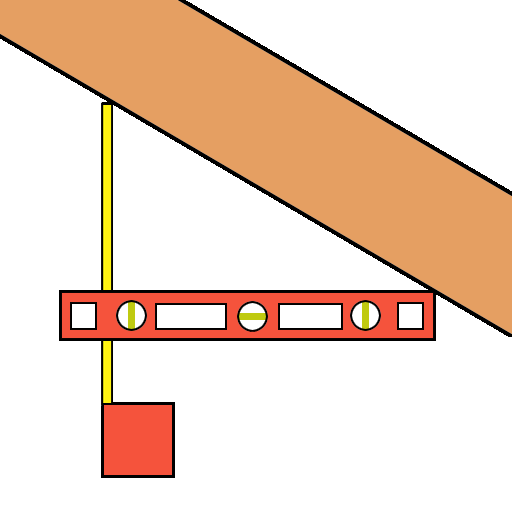Roof Pitch Calculator
Calculate roof pitch by entering the rise and run or the angle in degrees. Learn more about measuring roof pitch and the rise and run below.
Calculated Roof Pitch:
| pitch: | |
| per foot: | |
| grade (slope): | |
| degrees: | |
| radians: |
On this page:
How to Calculate Roof Pitch
All homes and buildings have roofs. They may range from flat to very steep, some may have curves, and others may have multiple peaks and valleys. All of these roofs have one thing in common; however, they all have what is known as a pitch. Roof pitch describes the slope, or angle, of the roof.
Even flat roofs have a pitch, albeit a small one, as that slope is required to prevent rain and snow from gathering.
Knowing a roof’s pitch is essential in determining what type of material should be installed on the roof, the appropriate installation method, and how much roofing material you’ll need. It’s also an important factor in cold climates for calculating snow load.
Roof pitch, or slope, is a measure of vertical rise to horizontal run expressed in inches per foot, which is referred to as rise over run.[1] Meaning that the roof is measured 12″ in from the edge in a horizontal line, then measured from this point straight up to where the roof intersects. A roof that rises 6″ vertically for every 12″ horizontally has a 6″ per foot, or a 6 in 12 pitch.
Thus, the pitch is the ratio of the rise in inches to a 12-inch run and is often expressed using a semicolon, for example, 6:12. Sometimes, the pitch is also expressed in fraction form using a fraction with a slash, such as 6/12.

You can measure roof pitch by finding the rise and run or by converting from the angle if it is known. See the chart below for the rise and run values for standard roof pitches.
We’ll cover four methods to calculate roof pitch below.
Method One: Measure From the Roof
One method to find the pitch is to climb on the roof and measure the rise for a 12″ run. You’ll need a level that is 12″ or longer and a tape measure.
On the roof, hold the level perfectly level, and measure the height from the roof to the level 12 inches away from where the level touches the surface; this will be the rise.
For example, if the end of a level is 4″ above the roof at a point 12″ away from where it meets the surface, then the pitch is 4:12.

Method Two: Measure From the Attic
Another method to find the roof pitch is to go into the attic and measure the rise over a 12″ run of the roof rafters, allowing you to find the pitch without going on the roof.
From the attic, hold a level perfectly level and touching a rafter at one end. Measure the distance from the level to the rafter 12 inches away from where the level touches the rafter.[2]

Method Three: Measure the Total Rise and Run
If you know the total height of the peak and the roof’s width, you can also find the pitch with a little math. For example, if the peak is 4 feet and the total roof width is 20 feet, then the total rise is 4 feet (48 inches).
The total run is the distance from the peak to the edge of the roof, which in this case is the total width divided in half, which is equal to 10 feet or 120 inches.

Since the pitch is the rise over a 12-inch run, you can divide the run by 12 to get the multiplier; in this case, 120 ÷ 12 = 10.
Then, divide the rise by the multiplier to get the pitch, e.g. 48 ÷ 10 = 4.8. The pitch of this roof is 4.8:12. The calculator above can handle much of this math.
Method Four: Measure With a Speed Square
You can also use a speed square and level to quickly measure the roof’s pitch. Set the level on the edge of the speed square as shown below, then place the heel of the speed square on a rafter or gable edge of the roof.
Holding the tools level, locate the measurement on the speed square where it meets the rafter’s bottom edge to find the angle of the roof in degrees.

How to Convert Angle in Degrees to Roof Pitch
If you know the roof’s angle in degrees, you can find the roof pitch by converting the angle in degrees to a slope, then finding the rise by multiplying the slope by 12.
First, find the slope by finding the tangent of the degrees, e.g. slope = tan(degrees). Then multiply the slope by 12 to get the rise. You can then express the pitch as inches per foot.
Example: let’s find the pitch for a roof angle of 35°.
slope = tan(35°) = 0.7002
rise = 0.7002 × 12 = 8.4
pitch = 8.4:12
How to Convert Roof Pitch to Degrees
To find the angle of a roof in degrees, convert the pitch to a slope, then convert to degrees by finding the slope’s inverse tangent, or arctangent. First, convert the pitch to a slope.
To do this, simply convert the rise and run as a fraction to a decimal form, e.g. rise/run = rise ÷ run = slope. For a pitch expressed in inches per foot, convert to a fraction first, e.g. a 4 in 12 pitch becomes 4/12, then divide.
Next, find the degrees by finding the slope’s inverse tangent, e.g. degrees = arctan(slope).
For example: let’s find the angle in degrees for a roof with a 4 in 12 pitch.
slope = 4:12 = 4 / 12 = .333
angle = arctan(.333)
angle = 18.4178°
Standard Roof Pitches
Most roofs have a pitch in the 4:12 to 9:12 range. A pitch over 9:12 is considered a steep-slope roof, between 2:12 and 4:12 is a low-slope roof, and less than 2:12 is a flat roof.[3]
The table below shows standard roof pitches and the equivalent grade and angle in degrees and radians for each.
| Pitch | Grade (slope) | Degrees | Radians |
|---|---|---|---|
| 1/8:12 | 1% | 0.6° | 0.01 |
| 1/4:12 | 2.1% | 1.2° | 0.02 |
| 1/2:12 | 4.2% | 2.4° | 0.04 |
| 1:12 | 8.3% | 4.8° | 0.1 |
| 2:12 | 16.7% | 9.5° | 0.2 |
| 3:12 | 25% | 14° | 0.2 |
| 4:12 | 33.3% | 18.4° | 0.3 |
| 5:12 | 41.7% | 22.6° | 0.4 |
| 6:12 | 50% | 26.6° | 0.5 |
| 7:12 | 58.3% | 30.3° | 0.5 |
| 8:12 | 66.7% | 33.7° | 0.6 |
| 9:12 | 75% | 36.9° | 0.6 |
| 10:12 | 83.3% | 39.8° | 0.7 |
| 11:12 | 91.7% | 42.5° | 0.7 |
| 12:12 | 100% | 45° | 0.8 |
| 13:12 | 108.3% | 47.3° | 0.8 |
| 14:12 | 116.7% | 49.4° | 0.9 |
| 15:12 | 125% | 51.3° | 0.9 |
| 16:12 | 133.3% | 53.1° | 0.9 |
| 17:12 | 141.7% | 54.8° | 1 |
| 18:12 | 150% | 56.3° | 1 |
| 19:12 | 158.3% | 57.7° | 1 |
| 20:12 | 166.7% | 59° | 1 |
| 21:12 | 175% | 60.3° | 1.1 |
| 22:12 | 183.3% | 61.4° | 1.1 |
| 23:12 | 191.7% | 62.4° | 1.1 |
| 24:12 | 200% | 63.4° | 1.1 |
How Pitch Affects the Cost of Roofing
The pitch of a roof will have a definite impact on the cost to install or replace it. Steeper roofs cost more to install, so bear that in mind when choosing the right pitch for your project.
A low-slope roof might cost 10% more to install than a flat roof, while a steep-slope roof might cost 20-30% more. Roofs with a very steep pitch might cost even more than that to install.
Pitch Variations and Unusual Roofs
Not every roof is going to have a perfect, easy-to-measure angle. Some homes may have two different pitches for the roof.
For example, a dual-pitch gable roof has a different pitch on each side of the home. Gambrel and Mansard roofs are considered dual-angle roofs. The lower part of the roof is actually an extension of your home’s walls. This pitch is not quite vertical, but it is close.
In addition, some Mansard roofs are concave on this lower section, which can make it seem to have a different pitch. Both sections need to have their pitch calculated separately. If the roof is concave, you will need to measure from the interior if possible, as the way the roof curves outward at the bottom will give it the illusion of a less steep pitch than it truly has.
Most Gambrel and Mansard roofs are 20/12 on the front section, with a more standard 7/12 on the upper portion.
In complex roofs, such as cross gables, which may have multiple roof areas, you may need to check the pitch of each one – never assume that each section has the same pitch, as it is common for them to vary.
If you’re considering a new roof, we suggest getting several estimates to learn more about the right pitch for your roof and understand the cost of installation. We also cover more about roof replacement costs in detail in our cost guide.
Frequently Asked Questions
What is the standard roof pitch?
A standard pitch is considered anything between 4/12 and 8/12. Anything below is considered low-slope or flat, while anything above is considered a high pitch.
What roof pitch is strongest?
Anything between 4/12 and 8/12 is usually considered a strong roof pitch. However, if you live in an area with a high snowfall, you may want to consider 9/12 or over, while if you live in an area with high winds, you want to consider 7/12, as this is the strongest pitch against high wind.
What angle is a 4/12 roof pitch?
A 4/12 roof pitch is equivalent to an 18.4 degree angle.
References
- Nick Gromicko and Benjamin Gromicko, Measuring Roof Slope and Pitch, International Association of Certified Home Inspectors, https://www.nachi.org/roof-slope-pitch.htm
- Robert C. Young, How to Measure Roof Slope Angles, Weekand, https://www.weekand.com/home-garden/article/measure-roof-slope-angles-18037637.php
- Evan Gillespie, What Is the Standard Roof Pitch?, Hunker, https://www.hunker.com/13401081/what-is-the-standard-roof-pitch


